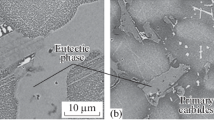Abstract
Based on the testing reported here, a new Ni-based superalloy has been adopted for use in Mazda RX-7 heat-resistant turbochargers. The new alloy exhibits a high temperature stability of the γ phase, resisting the initial stage of creep rupture. Casting parameters and chemistries are varied to produce a directionally solidified columnar structure, which eliminates internal grain boundary rupture sites. The Mazda super-high temperature turbocharger was used to achieve a world speed record (GT-C class) of 238.442 mph at Bonneville, Utah, last August.
Similar content being viewed by others
References
R. Yoda, “Development and Existing State of Super Heat Resistant Alloy,” Reference Material for Training Course, Chiba Technical College, July, 1982.
Nickel Base Alloys, Inco.
M. Yamazaki, “Nickel Base Superalloy Developed for Advanced Gas Turbine in Moonlight National Project,” International Gas Turbine Congress in Tokyo 1983.
H. Harada, M. Yamazaki, et al., “Special Quality for High Temperature m Normal Solidified Nickel Base-Heat Resistant Alloy for Moving Blade,” Tetsu to Hagane, March, 1983, Vol. 69, No. 5.
Ni-Resists and Ductile Ni-Resists, Inco.
The Super Alloys, Sims-Hangel Willey, M. Yamazaki, et al “Research and Development of: Heat Resistant Alloy in Moonlight National Project, High Efficiency Gas Turbine R&D,” The Metal Material Technology Research Center, The Science and Technology Agency, March, 1985.
Author information
Authors and Affiliations
Additional information
Masashi Yoritaka received his degree in metallurgy from the Kyoto University in 1965.
Yukio Yamamoto received his degree in the plasticity of metallic materials from Hiroshima University in 1979.
Yasuaki Hasegawa received his degree in metallurgy from Tohoku University in 1983.
Tomio Hokari received his degree in precision engineering from Ibaraki University in 1971.
Rights and permissions
About this article
Cite this article
Yoritaka, M., Yamamoto, Y., Hasegawa, Y. et al. Automotive Application of Advanced Superalloys. JOM 38, 20–22 (1986). https://doi.org/10.1007/BF03257589
Published:
Issue Date:
DOI: https://doi.org/10.1007/BF03257589




